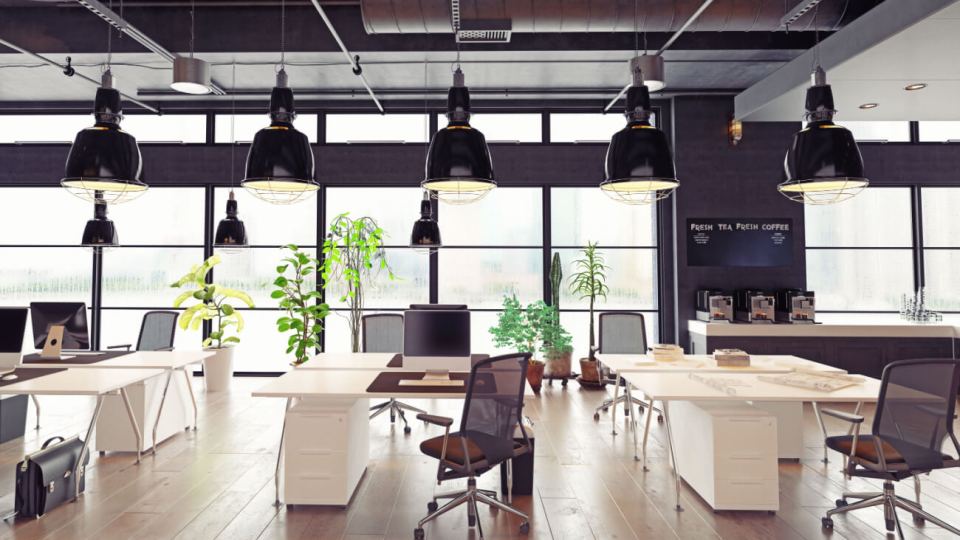Expert Insights: Scott Hamilton Discusses Open Office Design
 For the latest interview in our expert insights series, we had the pleasure of speaking with Scott Hamilton, senior project manager of acoustics for ESD, which is now Stantec Consulting Services.
For the latest interview in our expert insights series, we had the pleasure of speaking with Scott Hamilton, senior project manager of acoustics for ESD, which is now Stantec Consulting Services.
Hamilton has extensive experience working with acoustics and has successfully managed numerous projects, including data centers, concert halls, universities, health care facilities and major league baseball stadiums. He believes that when acoustics are fully integrated into every design decision, they blend in seamlessly with the artistic expression of architecture and interior design. Hamilton is also a member of the Acoustical Society of America. Read on for his insights.
Q. Could you tell us a little about yourself and why you chose your career?
I’ve been an acoustics consultant for 14 years across the United States and Canada. I chose acoustics as it was a blend of my interests in engineering and music. While looking for the appropriate school to pursue these passions, I found Purdue was in the process of accrediting a program in an acoustics-specific track of engineering. From the start, my career has been eclectic, covering the design of a wide range of industries from offices to large-scale industrial properties to concert halls and everything in between. In my free time, I play guitar, bike Chicago’s lakefront trail and compete as the unfairly tallest guy in my rec volleyball league.
Q. How has the open office design evolved in recent years, and what does the future hold?
The open office has gotten more and more open; privacy partitions are going away; and we are seeing more and more hoteling. The individual workspace is becoming less personal, and technology is more portable.
We are increasingly online and remote. Meetings are leaving conference rooms and now include team members all over the office. Chat apps are replacing in-office discussions. We’re seeing coworkers set up a video call instead of walking across the office to talk. If there is a meeting in a conference room, often at least one member is not in the room.
The ‘rise’ of standing desks — in combination with the lowering of privacy screens — results in less barriers to block the sound of a standing employee versus those seated.
In the immediate future, I see teams adopting coworking models. More and more employees will get used to the idea of not having ‘their’ desk and adopt a hoteling model based on what they need for that day. I can see more offices having different types of workstations that employees use at different times of the day.
Q. What are the benefits of adopting an open office layout?
Eavesdropping. Early in my career, the people I sat by were instrumental in my development. Several of the things I learned early on were from being in proximity to discussions that I may not have been a part of otherwise. Having a mentor to follow-up with me after these conversations to clarify what I didn’t understand was also beneficial. I try and replicate a similar model with my team members, encouraging a ‘headphones off’ policy when other team members have a design discussion. Also, being aware of what other team members were working on allows others to come in and support with less ramp-up time.
Another benefit is what I call collaboration opportunities/collisions. Being around your team members — both socially and for the added resources they provide — will create new opportunities and innovations. In a healthy office, colleagues should inspire each other and, when given the opportunity, can complement skills gaps and insights that would not happen in a vacuum. The ease of having a conversation with a colleague, versus the extra steps required to set up a call, can make a significant difference.
Working together in person also affords visual transparency. You can see your whole team. There is a LOT communicated through body language, particularly stress and workload. By seeing each other in person, we are more sensitive and attuned to what’s going on.
There is a very real economic incentive to develop shared office space. Reduced construction cost and time versus building private offices. It’s hard to beat the cost per employee of an open office fit out. Building walls, doors, heating, ventilation, air conditioning (HVAC) controls and everything else involved in building out an office are expensive. Open offices are still the most economical.
The open office is also easier to adapt as needs change. By omitting permanent walls, the floorplan can be easily rearranged. Modular collaboration spaces and phone booths are a great example of how manufacturers have stepped into the gap with products that allow users to reconfigure their spaces as they grow and reshuffle their layouts.
Finally, open office designs often allow for more shared natural light. Traditionally, offices lined the outside of the floor with private offices with the open office pool in the center, blocking light. More contemporary designs have now flipped that design, which allows the windows to be viewable to all team members.
Q. On the other hand, what are the drawbacks that come with it?
Naturally, the acoustics! Excess noise exposure can contribute to fatigue and stress, as well as result in unnecessary distractions and disrupted workflow. Open offices inherently lack privacy. Everyone can see and hear what you’re doing. There is also a very real sense of a lack of control. You can’t just close your door when you need more privacy. You’re always exposed to people approaching you with new problems.
Q. What is your opinion on whether an open office layout affects productivity?
It absolutely does in both positive and negative ways. A busy office can be energizing and motivating, but others may be distracted and not want to socialize. The ability to lean over and ask a question of who sits by you is convenient, but can annoy others who don’t want to hear you.
As a hybrid employee, I love the ability to macro out my work. I intentionally plan on different types of work for the days I’m in office and days I’m remote. I try to plan on not doing online calls when in office and focus on in-person meetings. I reserve tasks where I don’t want to be interrupted for when I’m working remote. I find we wait to talk to other team members until we’re together and will hold off on calling each other when remote.
Q. What are the pitfalls of opting for a one-size-fits-all approach to implementing an open office plan?
One size fits none. Even in the same company, most people have different roles and needs. It can be detrimental to provide the wrong space for the wrong job. Some roles need to be separated. We had a project for a financial client where they positioned their trading bullpen next to their quantitative analysts, and the boisterousness of the traders drove the quiet quant team members nuts while they were trying to focus on complex computations.
Some people are just louder than others and they have no idea they’re doing it. Some people are more sensitive to noise than others. The two should not be forced to mix.
Q. How important is it to communicate with employees before implementing any office layout or plan changes?
It is imperative [that] users know how things are intended, even if people won’t follow the rules. If an area is intended for quiet reflection and someone decides to use it for personal calls, it’s ruining it for everyone. If all the phone booths and conference rooms are signed out all day because a user wants a private office, it’s a problem.
The office is a tool. If you give people the wrong tool or don’t teach them how to use it, they can cause damage, instead of being constructive. A bad office can ruin productivity and morale.
Uptake and proper usage of a design element requires that its use is intuitive. If it’s too difficult to figure out, people won’t use it. Many offices use audio visual systems in meeting rooms that can take a long time to connect or require the help of IT to set up.
Finally, if the design element is too far away, people won’t use it. If all the collaboration spaces are on the other side of the office, most people will just meet in a space that’s convenient for them. It needs to flow. People do not want to stop or break their flow state to use a new tool. It just needs to fit with how they’re working.
Q. It’s hard to find a plan that accommodates the needs of everyone. Are there alternatives that can be used by specific employees who prefer privacy, rather than an open layout?
The most common solution you see are headphones, and you see a lot of them. However, if everyone is wearing headphones, it creates problems or eliminates benefits. For example, the benefit of listening to each other goes away. It also makes employees look unavailable, which creates a hurdle to collaboration. If people are coming into the office just to act like strangers, what’s the advantage to them coming in?
There are also health risks. Using headphones can result in too much noise exposure as most people aren’t actively tracking the sound levels and duration of their music. It has been clinically demonstrated that prolonged listening to music at a high level can cause hearing damage. Spending a day with your headphones cranked could exceed OSHA limits for sound exposure.
Headphones can be isolating in another way: When people cover their ears, they become less aware of the noise they make. With the high number of calls and meetings taking place at their desk now (in lieu of a private room), being able to have these meetings quietly becomes more important. When you have both ears covered with noise-isolating headphones on, you will likely talk louder and annoy your peers with your calls.
There are some viable solutions. Companies are adding phone booths and small meeting spaces. These allow a short-term private space for a meeting or call, or just an intense focus session. Often, company cultures that adopt these quickly realize they need more because they book out. Temporary/modular phone booths have been a hot product on the market. Mobility is key. With more options for a place to work, employees can pick up and move to another space that suits their work, [and] this can be as simple as chairs in the break room or along the windows.
When I used to work in a coworking space, I’d spend some time in a desk; I’d get up and walk around when on a call; I’d go in meeting rooms; and then I’d sit on a couch when I was doing certain tasks. The different locations helped me focus on the task at hand and then switch gears to a new task when I was in a new location. This includes having a mobile solution where people can easily take a call or use multiple screens in a call or concentration space. Buy-in from management is important. They have to be ok with not having [a] constant line of sight on their team.
Q. Are there any other insights that you’d like to share?
Designing a successful open office on paper and it being one are different things. A successful design is entirely dependent on behavior. Our designs need to be around the people first and foremost, and we need to think about how our designs, in turn, affect those who are in it.
Interested in being interviewed for our Expert Insights series? Feel free to reach out to us at contributors@commercialcafe.com or check out other articles from our series here.

